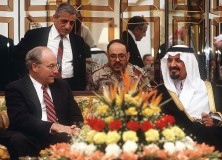Building and Maintaining the Gulf War Coalition — Ryan Arant

INTRODUCTION:
The pretext for the Persian Gulf War and the formulation of the global coalition against Iraq was the decision made by Iraqi President Saddam Hussein to invade the neighboring state of Kuwait. Arguably the first case of unilateral state aggression since the end of the Cold War, the August 2, 1990 invasion and subsequent annexation of Kuwait by Iraq threatened key U.S. interests on a number of fronts. American policy makers began to build an international coalition against Iraq immediately after reports of the invasion reached Washington. By the end of August, Washington had assembled an unprecedentedly broad and diverse coalition to defend Saudi Arabia in Operation Desert Shield and subsequently liberate Kuwait in Operation Desert Storm. Though the Gulf War coalition narrowed the military options of the Bush administration, it was instrumental in assisting the United States achieve the primary Gulf War goal: the restoration of Kuwaiti sovereignty.
STRATEGY:
The Bush administration refrained from over-utilizing existing security institutions such as NATO to build the coalition because such organizations were not sufficiently diverse to provide the United States the level of international legitimacy it deemed necessary to move against Iraq. While the administration did use the United Nations as a tool for diplomacy and relied heavily on its historically strong relationships with key Security Council members to support its agenda, a large portion of the coalition was built from scratch and had little or no precedent. Since the Bush administration assembled the coalition for the expressed purpose of mollifying both global and domestic opposition to American military engagement, the coalition formed was broad, rather than politically congruous. While this provided the intended legitimizing effect, conflicts of interest between coalition members eventually led to the constraint of military options and U.S. objectives.
INTEGRATED ELEMENTS OF NATIONAL POWER:
Bureaucratic and interagency conflict was sparse and did not prevent Washington from developing a unified, comprehensive, and cohesive strategy to build and maintain the coalition against Iraq. The National Security Council, the Joint Chiefs of Staff, and the CIA worked well with the Departments of State, Defense, and Treasury to formulate policy objectives, coordinating with one another through formal and informal groups. The multi-agency Deputies Committee was highly coordinated, responsive, and served as a coalition crisis management team. During the course of the coalition building process and the war, the Deputies Committee proved to be highly effective in this role, particularly in managing the response to President Hussein’s launching Scud missiles into Israel.
EVALUATION:
High level dialogue, cooperation, and trust between administration officials led to the formulation of diplomatic policies and strategies which uniformly supported the agenda of President Bush and ultimately contributed to the success of the coalition. After years of working together in the upper echelons of American government, President Bush and his national security team had both the expertise and the “chemistry” necessary to quickly formulate and execute a strategy in response to the crisis, even while operating in a virtual policy vacuum. Importantly, they also operated within the framework of informal groups which best suited the direct leadership style of the President but also gave team members the ability to operate and communicate with relatively high level of independence. However, while the administration was highly successful diplomatically, the design of the coalition could not accommodate all U.S. objectives. This oversight can primarily be attributed to the lack of specific American policies in regard to Iraq prior to Iraq’s unanticipated invasion of Kuwait. With the crisis demanding a swift response and action from the administration, the Bush team did not have time to adequately evaluate all potential objectives before formulating and executing their strategy in response to the invasion.
RESULTS:
The success of the coalition building effort gave the United States both the domestic and international legitimacy it required to accomplish the Bush administration’s primary objective of ending the Iraqi occupation of Kuwait. However, the coalition also hampered the United States ability to complete stated goals and ruled out adopting more ambitious objectives. Coalition induced tactical errors and the necessity to maintain coalition consensus prevented the U.S. military from completely destroying the retreating Iraqi Republican Guard, an important goal of the President and his national security team. It also eliminated the option for the United States to pursue to removal of Saddam Hussein and the Baathist regime in Iraq, a goal which some analysts assert was seriously considered by the administration.
CONCLUSION:
In contrast to the current war in Iraq, which has been undermined from the outset by the relative absence of international support, the conduct of the U.S. government before and during the Persian Gulf War reveals how the national security system can successfully build and leverage a coalition. While the limits imposed by the coalition were burdensome, no scholar has persuasively outlined an alternative strategy which would have enabled the United States to achieve all possible objectives without greatly increasing the political and/or military losses for Washington. However, had a comprehensive long-term policy in regard to Iraq been available, the Bush administration may have had the freedom to undertake a more calculated strategy and been better prepared to weigh the advantages and disadvantages of each policy option against long-term goals in the region.